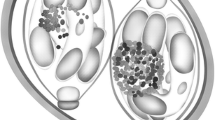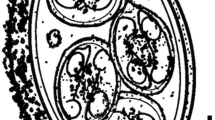Abstract
Introduction
A new coccidian species of the genus Eimeria Schneider, 1875 (Apicomplexa: Eimeriidae), is reported from the bat host Myotis riparius Handley from Ilha Grande, a large island off the coast of the State of Rio de Janeiro, in southeastern Brazil.
Methods
Bats were captured in 13 mist nets (10 × 3 m), which were set within the experimental plots, and through active searches of the daytime roosts of Molossus molossus Pallas found in Vila Dois Rios. Containment was made in bags for the collection of feces and identification of coccidia. A survey was conducted on the coccidia species described so far (Table 2).
Results
The oöcysts of Eimeria riparii n. sp. are ellipsoidal to cylindroidal with an extremely thin, bi-layered wall, slightly rough. Two polar granules are present, micropyle and oöcyst residuum are both absent. The sporocysts are ellipsoidal, the sporocyst residuum is formed by sparse, rounded granules of varying sizes; the Stieda body is trapezoidal and a sub-Stieda body is absent. Sporozoites are banana shaped. With the new species described here, a total of 40 Eimeria spp. have been described infecting bat hosts, belonging to 30 species of 18 genera and 5 families.
Conclusion
The subsequent increase in the known diversity of bats has been derived from the ongoing expansion of research in a number of different areas of taxonomy and ecology although the number of studies of the associated coccidian parasites of the family Eimeriidae has increased more slowly.



Similar content being viewed by others
References
Alyousif MS, Al-Dakhil M, Al-Shawa Y (1999) Eimeria pipistrellus n. sp. from Pipistrellus kuhlii (Chiroptera: Vespertilionidae) in Saudi Arabia. Korean J Parasitol 37:1–4
Alyousif MS (1999) Eimeria kuhliensis sp. n. (Apicomplexa: Eimeriidae) from pipistrelle bat Pipistrellus kuhlii. Acta Protozool 38:313–316
Alyousif MS (1999) Eimeria chiropteri n.sp. (Apicomplexa: Eimeriidae) from Saudi Arabian bat Pipistrellus kuhlii (Chiroptera: Vespertilionidae). J Egypt Soc Parasitol 29:275–280
Barquez RM, Mares MA, Braun JK (1999) The bats of Argentina. Museum Texas Tech Univ 42:1–275
Barquez RM, Ojeda RA (1992) The bats (Mammalia: Chiroptera) of the Argentine chaco. In: Annals of the Carnegie Museum, Pittsburgh, pp 239–261
Bray RS (1958) On the parasitic protozoa of Liberia. I. Coccidia of some small mammals. J Protozool 5:81–83. https://doi.org/10.1111/j.1550-7408.1958.tb02530.x
Cerná Z (1976) Eimeria vejsovi sp. n. from the bat Nyctalus noctula. Folia Parasitol (Praha) 23:187–191
Cody ML, Smallwood JA (1996) Long-term studies of vertebrate communities. Academic Press, Cambridge
Duszynski DW (1997) Coccidia from bats (Chiroptera) of the world: A new Eimeria species in Pipistrellus javanicus from Japan. J Parasitol 83:280–282. https://doi.org/10.2307/3284456
Duszynski DW (2002) Coccidia (Apicomplexa: Eimeriidae) of the mammalian order Chiroptera. Spec Publ Mus Southwest Biol 5:1–45
Duszynski DW, Barkley LJ (1985) Eimeria from bats of the world: a new species in Tomopeas ravus from Peru. J Parasitol 71:204–208. https://doi.org/10.2307/3281903
Duszynski DW, Reduker DW, Parker BB (1988) Eimeria from bats of the world. II. A new species in Tadarida femorosacca from Sonora. Mexico J Parasitol 74:317–321
Duszynski DW, Scott DT, Aragon J, Leach A, Perry T (1999) Six new Eimeria species from vespertilionid bats of North America. J Parasitol 85:496–503
Duszynski DW, Scott DT, Zhao X (1999) Eimeria from bats of Bolivia: Two new species from Vespertilionid Bats. J Parasitol 85:504–507
Duszynski DW, Wilber PG (1997) A guidelines for the preparation of species description in the Eimeriidae. J Parasitol 83:333–336. https://doi.org/10.2307/3284470
Esbérard CEL (2006) Efeito da coleta de morcegos por noites seguidas no mesmo local. Rev Br Zool 23:1093–1096. https://doi.org/10.1590/S0101-81752006000400016
Esbérard CEL, Jordão-Nogueira T, Luz JL et al (2006) Morcegos da Ilha Grande, Angra dos Reis, RJ, Sudeste do Brasil. Rev Bras Zoociências 8:151–157
Fenton MB, Simmons NB (2015) Bats: a world of science and mistery. University of Chicago Press, Chicago, p 303
Findley JS (1993) Bats: A community perspective. Cambridge University Press, Cambridge, p 167
Frey JK, Yates TL, Duszynski D et al (1992) Critical comment: Designation and curatorial management of type host specimens (Symbiotypes) for new parasite species. J Parasitol 24:930–932
Gottschalk C (1974) Eine neue Kokzidienart aus dem Abendsegler (Nyctalus noctula). Angew Parasitol Jena 15:3–5
Humason GL (1979) Animal tissue techniques. W.H Freeman, San Francisco
Kalko EK V., Handley CO, Handley D (1996) Organization, diversity, and long-term dynamics of a neotropical bat community. In: long-term studies of vertebrate communities. pp 503–553.
Kheysin YM (1972) Life cycles of coccidia of domestic animals. University Park Press, Baltimore, p 276
Lainson R (1968) Parasitological studies in British Honduras III. Some coccidial parasites of mammals. Ann Trop Med Parasitol 62:260–266. https://doi.org/10.1080/00034983.1968.11686557
Lainson R, Naiff RD (1998) Eimeria peltocephali n. sp., (Apicomplexa:Eimeriidae) from the freshwater turtle Peltocephalus dumerilianus (Chelonia:Pelomusidae) and Eimeria molossi n. sp., from the bat, Molossus ater (Mammalia: Chiroptera). Mem Inst Oswaldo Cruz 93:81–90. https://doi.org/10.1590/S0074-02761998000100015
Lainson R, Naiff RD (2000) On Eimeria bragancaensis n. sp. (Apicomplexa: Eimeriidae) and tissue-cysts of an unidentified protozoan in the bat Peropteryx macrotis (Chiroptera: Emballonuridae) from Amazonian Brazil. Parasite 7:123–129. https://doi.org/10.1051/parasite/2000072123
Laval RK, Rodríguez HB (2002) Murciélagos de Costa Rica. Instituto Nacional de Biodiversidad, San José, p 320
Lavier G (1924) Eimeria hessei n. sp., coccidie intestinale de Rhinolophus hipposideros. Ann Parasitol Hum Comparée 2:335–339
Lavier G (1927) Eimeria dukei n.sp., coccidie parasite intestinale de Chéiroptère. Comptes Rendus des Séances La Société Biol ses Fil Assoc Paris 97:1707–1709
Magnusson WE, Lima AP, Luizão R et al (2005) RAPELD: A modification of the gentry method for biodiversity surveys in long-term ecological research sites. Biota Neotrop 5:21–26. https://doi.org/10.1590/S1676-06032005000300002
Mandal A, Nair KN (1973) A new species of coccidium from Taphozous melanopogon Temminek (Mammalia: Chiroptera) from Andaman Islands. Zool Surv India 243–246
Marinkelle CJ (1968) Eimeria eumopos n. sp. from a Colombian bat Eumops trumbulli. J Protozool 15:57–58. https://doi.org/10.1111/j.1550-7408.1968.tb02089.x
Marquardt WC, Senger CM, Seghetti L (1960) The effect of physical and chemical agents on the oocyst of Eimeria zurnii (Protozoa, Coccidia). J Protozool 7:186–189. https://doi.org/10.1111/j.1550-7408.1960.tb00728.x
McAllister CT, Burt S, Seville RS, Robison HW (2011) A new species of Eimeria (Apicomplexa: Eimeriidae) from the eastern pipistrelle, Perimyotis subflavus (Chiroptera: Vespertilionidae), in Arkansas. J Parasitol 97:896–898. https://doi.org/10.1645/GE-2761.1
McAllister CT, Seville RS, Arlen R, Connior MB (2014) A new species of Eimeria (Apicomplexa: Eimeriidae) from tri-colored bats, Perimyotis subflavus (Chiroptera: Vespertilionidae), from the Ouachitas of Arkansas. Acta Parasitol 59:690–693. https://doi.org/10.2478/s11686-014-0297-0
McAllister CT, Seville RS, Bursey CR (2017) Helminth (Cestoda, Nematoda) and coccidian (Apicomplexa: Eimeriidae) parasites of the eastern small-footed myotis, Myotis leibii (Chiroptera: Vespertilionidae) from Arkansas, with a description of a new species of Eimeria. Acta Parasitol 62:377–381. https://doi.org/10.1515/ap-2017-0044
McAllister CT, Seville RS, Roehrs ZP (2012) A new species of Eimeria (Apicomplexa: Eimeriidae) from the northern myotis, Myotis septentrionalis (Chiroptera: Vespertilionidae), in Oklahoma. J Parasitol 98:1003–1005. https://doi.org/10.1645/GE-3119.1
McAllister CT, Upton SJ (2009) Two new species of Eimeria (Apicomplexa: Eimeriidae) from eastern red bats, Lasiurus borealis (Chiroptera: Vespertilionidae), in Arkansas and North Carolina. J Parasitol 95:991–993. https://doi.org/10.1645/GE-1967.1
Mussaiev M, Weissov AM (1961) A new coccidium species from Vespertilio kuhlii Kuhl (in Russian). Dollady Akad Nauk Azerbaidzhan SSR 17:741–743
Mussaiev MA (1967) A new species of coccidia, Eimeria zakirica, from the Mediterranean bat Vespertilio kuhlii Kuhl (in Russian). Izv Akad Nauk Azerb SSR Ser Biol Nauk 5:37–38
Mussaiev MA, Gauzer ME (1971) Eimeria mehelyi, a new species of coccidium from Rhinolophus mehelyi (in Russian). Izu Akad Nauk Azerb SSR Biol Nauk 2:94–96
Muylaert RDL, Stevens RD, Esbérard CEL et al (2017) Atlantic bats: a data set of bat communities from the Atlantic forests of South America. Ecology 98:3227. https://doi.org/10.1002/ecy.2007
Novaes RLM, De França SR, Moratelli R (2017) Myotis riparius (Chiroptera: Vespertilionidae). Mamm Species 49:51–56. https://doi.org/10.1093/mspecies/sex011
Root RB (1967) The niche exploitation pattern of the blue-gray gnatcatcher. Ecol Monogr 37:317–350
Scott DT, Duszynski WD (1997) Eimeria from bats of the world: Two new species from Myotis spp. (Chiroptera: Vespertilionidae). J Parasitol 83:495–501. https://doi.org/10.2307/3284416
Simmons N (2005) Order Chiroptera. In: Wilson DE, Reeder DM (eds) Mammal species of the world: a taxonomic and geographic reference, 3rd edn. Johns Hopkins University Press, Baltimore, pp 312–529
Straube FC, Bianconi GV (2002) Sobre a grandeza e a unidade utilizada para estimar esforço de captura com utilização de redes-de-neblina. Chiropt Neotrop 8:150–152
Tinnin DS, Jensen ET (2012) Gardner SL (2012) Coccidia (Apicomplexa: Eimeriidae) from Vespertilio murinus and Eptesicus gobiensis (Chiroptera: Vespertilionidae ) in Mongolia and how many species of coccidia occur in bats ? Erforsch biol Ress Mongolei 12:117–124
Todd KS, Hammond DM (1968) Life cycle and host specificity of Eimeria callospermophili Henry, 1932 from the Uinta ground squirrel Spermophilus armatus. J Protozool 15:1–8. https://doi.org/10.1111/j.1550-7408.1968.tb02083.x
Upton SJ (2000) Suborder Eimeriorina Léger, 1911. In: Lee JJ, Leedale GF, Bradbury P (eds) An Illustrated guide to the protozoa, 2nd edn. Allen Press Inc, Lawrence, Kansas, pp 318–339
Wheat BE (1975) Eimeria macyi sp. n. (Protozoa: Eimeriidae) from the eastern pipistrelle, Pipistrellus subflavus, from Alabama. J Parasitol 61:920–922. https://doi.org/10.2307/3279236
Wilber PG, McBee K, Hafner DJ, Duszynski DW (1994) A new coccidian (Apicomplexa: eimeriidae) in the northern pocket gopher (Thomomys talpoides) and a comparison of oocyst survival in hosts from radon-rich and radon-poor soils. J Wildl Dis 30:359–364
Yang-Xian Z, Fu-Qiang C (1983) A new species of the genus Eimeria (Sporozoa: Eimeriidae) from Myotis ricketti Thomas. Acta Zootaxonomica Sin 8:1–3
Acknowledgements
We are grateful to the Center of Environmental Studies and Sustainable Development (CEADS), Rio de Janeiro State University (UERJ), and the Rio de Janeiro State Institute for the Environment (INEA) for logistical support during the present study. We would also like to thank the members of the Mammalian Ecology Laboratory (LEMA) for their support during fieldwork.
Funding
HGB thanks FAPERJ for a CNE Grant (E-26/202.757/2017), and Prociência/UERJ and CNPq (307781/2014-3) for research and productivity grants. LMC thanks FAPERJ and CAPES for a postdoctoral scholarship and bench fees (E-26/101.399/2014).
Author information
Authors and Affiliations
Corresponding author
Additional information
Publisher's Note
Springer Nature remains neutral with regard to jurisdictional claims in published maps and institutional affiliations.
Rights and permissions
About this article
Cite this article
de Santana Miglionico, M.T., Costa, L.M., Mota, E.M. et al. A New Species of Eimeria Schneider, 1875 (Apicomplexa: Eimeriidae) from Myotis riparius Handley, 1960 (Chiroptera: Vespertilionidae) in the Atlantic Forest of Brazil, with a Checklist of Eimeria spp. Reported from Bats. Acta Parasit. 65, 496–503 (2020). https://doi.org/10.2478/s11686-020-00182-6
Received:
Accepted:
Published:
Issue Date:
DOI: https://doi.org/10.2478/s11686-020-00182-6




